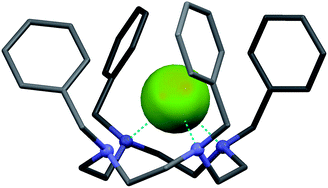Tetrabenzylcyclen as a receptor for fluoride†
Abstract
A tetraazacyclic

* Corresponding authors
a
Odessa National Medical University, Valikhovskiy lane, 2, Odessa, Ukraine
E-mail:
vgelmboldt@te.net.ua
b
Odessa State Environmental University, Lvovskaya str., 15, Odessa, Ukraine
E-mail:
edganin@gmail.com
c Lustdorfskaya doroga, 86, 65080 Odessa, Ukraine
d
Schulich Faculty of Chemistry, Technion-Israel Institute of Technology, Technion City, 32000 Haifa, Israel
E-mail:
botoshan@tx.technion.ac.il
e
Institute of Applied Physics, Academy of Sciences of Moldova, Academiei str., 5, MD-2028 Chişinău, R. Moldova
E-mail:
fonari.xray@phys.asm.md
Fax: (+373 22) 72 58 87
Tel: (+373 22) 73 81 54
A tetraazacyclic

 Please wait while we load your content...
Something went wrong. Try again?
Please wait while we load your content...
Something went wrong. Try again?
V. O. Gelmboldt, E. V. Ganin, S. S. Basok, E. Yu. Kulygina, M. M. Botoshansky, V. Ch. Kravtsov and M. S. Fonari, CrystEngComm, 2011, 13, 3682 DOI: 10.1039/C1CE05279A
To request permission to reproduce material from this article, please go to the Copyright Clearance Center request page.
If you are an author contributing to an RSC publication, you do not need to request permission provided correct acknowledgement is given.
If you are the author of this article, you do not need to request permission to reproduce figures and diagrams provided correct acknowledgement is given. If you want to reproduce the whole article in a third-party publication (excluding your thesis/dissertation for which permission is not required) please go to the Copyright Clearance Center request page.
Read more about how to correctly acknowledge RSC content.
 Fetching data from CrossRef.
Fetching data from CrossRef.
This may take some time to load.
Loading related content
